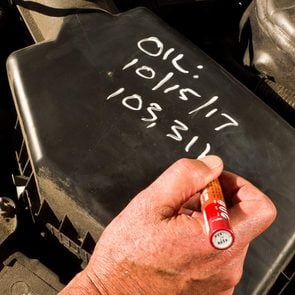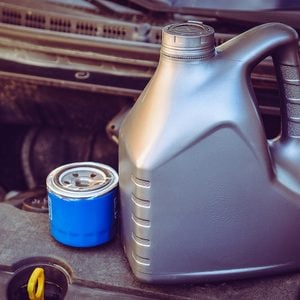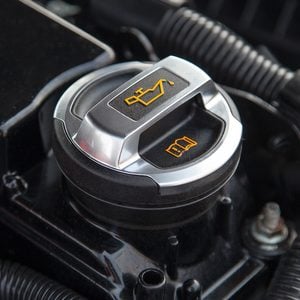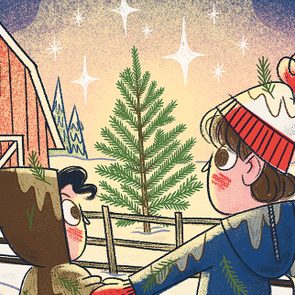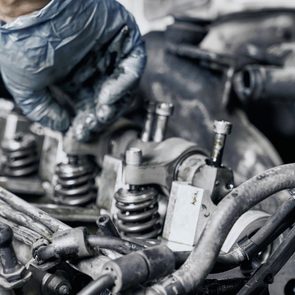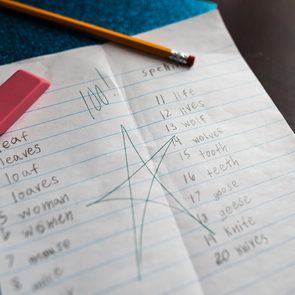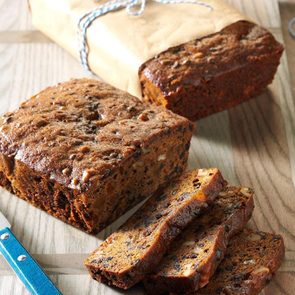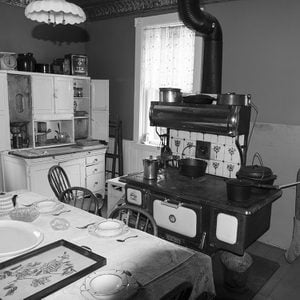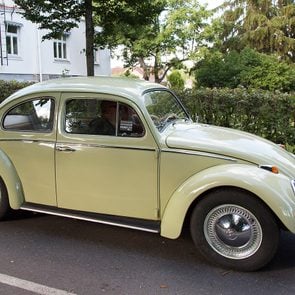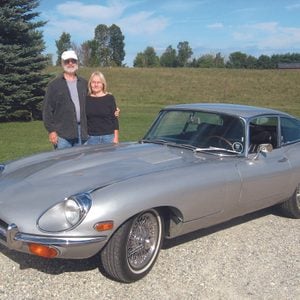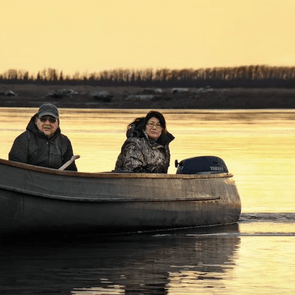Changing your oil is one of the easier maintenance tips that will extend the life of your car. The trick is remembering to change it. So how often should you change your oil? Here’s what experts say you need to know.
How often should you change your oil?
Two factors determine when you’ll need to change your oil—time and kilometres, according to Jake McKenzie, the Content Manager of Auto Accessories Garage. “Both time and kilometres will allow the oil to break down and become a less effective lubricant for your engine,” McKenzie says.
If you can, check the owners manual for specific oil intervals and the type of oil your car needs, Lauren Fix, a car expert, and ASE certified technician, suggests. The proper oil changes for your specific make and model come from the manufacturer. One of the ways you’re wasting money on your car is assuming all vehicles are created equal. The rule of thumb for most vehicles, however, is to change your oil after at least 8,000 kilometres. Still, some cars might only require full synthetic oil changes after 12,000 to 16,000 kilometres, according to Fix. “For many years, the standard advice was every 5,000 kilometres or three months, whichever comes first,” McKenzie says. “But thanks to improvements in modern engines and modern oils, most cars can comfortably drive at least 8,000 kilometres or even up to 16,000 kilometres on the same oil.”
For people who aren’t keeping track of their kilometres, another way to know it’s time to change your oil is looking at the dipstick. (Find out how to check oil like the pros.) When it’s dark, it’s time to change the oil, according to McKenzie. Newer cars might even have an oil change light on the dashboard to take out the guessing work. Once you do change your oil, Fix says to opt for the synthetic variety because it’s a better lubricant. It costs more, but mechanics know you’ll get more kilometres between changes.
What happens if I don’t change my oil?
Over time, the chemical structures in the oil break down and make it a less effective lubricant, according to McKenzie. And the oil is there to reduce friction, which causes heat. So if you leave your oil unchanged long enough, you’re asking for trouble and a hot engine. “This will at first make your vehicle run less efficiently, but eventually it will destroy your engine, effectively totalling your car,” McKenzie says. If left long enough, the entire engine will shut down, and you’ll have to replace it.
Those who do keep up with regular oil changes will reap the rewards for their car and wallet. According to Fix, keeping up with oil changes helps engines last longer and offers better fuel economy, too. Not changing your oil often enough is one way you’re shortening the life of your car.
Can I just add some fresh oil?
Just adding oil to your car is a huge mistake. You have to actually change your oil to get rid of the dirt and grime built-up in your engine, which isn’t the same thing as simply adding more oil, Fix says. Plus, your oil shouldn’t be going anywhere, unless there’s a leak, McKenzie says. If there’s room to add more oil or your levels are low, you could have a larger issue like an oil leak. A car in good condition, however, only needs a routine oil change. If you’re refilling any of your car’s fluids every month, it’s one of signs your car is about to die.
In the late 1960s my father purchased a fake Christmas tree from Canadian Tire. It had long plastic needles, forest green with a hint of neon, and it smelled of chemicals. Its natural habitat was indoors amid polyester curtains and shag carpet. No one could ever mistake it for an actual tree.
My four older brothers and I adored that tree. Every year the five of us looked forward to the mid-December Sunday, after Mass, when our father would reach up to the highest shelf in the basement storage room and pull down the box of tree parts for us to assemble: first the aluminum stand, then the broomstick trunk, then the branches of varying lengths. My father padded the box with old newspapers, and we’d laugh at the headlines featuring politicians, athletes and celebrities of yore. It was a ritual all our own, and we delighted in it every year.
Other kids—and parents—were politely aghast at our tree. They said Christmas wasn’t Christmas without a real tree, and there was no point telling them how wrong they were. We knew it was absolutely possible to invest love and joy and gratitude in a fake tree, because that’s what we did. And our tree radiated as much true warmth as anyone’s.
Years later, as I grew up and caught glimpses of my friends’ traditions, I came to realize that we weren’t the only household with holiday quirks. Every family Christmas is an elaborate performance that looks weird from the outside—that’s precisely the source of its charm.
My brothers and I, even in adulthood and scattered across the continent, always made the late-December pilgrimage to our parents’ cottage in Canmore, Alberta, and to the familiar comforts and lifelong relationships that reconnected us to each other and to ourselves. I never even imagined celebrating Christmas anywhere else until I got married.
When you marry someone, the saying goes, you marry their family as well, and that includes their holiday rituals. When Lynn and I were wed in 2003, we did what most young couples do: we visited both our parents’ homes for the holidays.
Living in Peterborough, Ontario, we drove to Montreal to celebrate Christmas Eve with Lynn’s parents and brother and his family, where Christmas was never complete without herring salad, apparently a German tradition. Christmas morning was then spent travelling, as we flew to Calgary and drove to Canmore for the ever-growing Preville family gathering ’round the ol’ fake tree.

Then Lynn gave birth to our first son, and a few years later, to his twin baby brothers, and Christmas turned into a nightmare: long drives with three squirmy kids in the back, followed by long flights with our family of five squeezed into three economy seats strewn with board books and binkies.
My family’s brood had swollen to the point where we no longer fit in my parents’ home, so we’d set ourselves up in a rented condo and shuttle back and forth for baby feedings and early bedtimes. But we never acknowledged to each other how exhausting our holiday routine had become, because we wanted to give our children the same joys of Christmas that we knew as kids.
The other thing we didn’t acknowledge was that those holiday joys were waning fast. Travel weariness was only part of the problem; our relationships with our parents and siblings were increasingly stilted. We were all professionals with careers and parents with kids, yet in both households everyone treated each other like the teenagers we once were, not the adults we had become. Christmas was stuck in time, and so were we.
It all came to a head during the Quarantine Christmas of 2011. That’s the year we and our three sons came down with norovirus on the flight to Calgary. We holed up in our rented condo and spent the first 48 hours voiding our gastrointestinal tracts and the next 48 trying to ward off my mother, who see-sawed between loving concern (“I made you some chicken soup!”) and browbeating (“Enough is enough, come join the family!”).
We couldn’t get out of Canmore fast enough. By the time we did I was so strung out that, with my extended family present to wave goodbye, I backed the minivan into a signpost on the way out of the parking lot, leaving the bumper dangling. I drove to the airport in silence, knowing, with a mix of resignation and determination, that I was done going home for the holidays.
Every Family Christmas is an elaborate performance, and we are all so attached to our part in the play that we lose track of both the script and the audience. Who are we performing for, and why? We do it to reconnect with the family roles and relationships that shaped us in our formative years, but it’s a double-edged sword.
Since Lynn and I are the youngest in our families, that often meant being treated like, and behaving like, the “kid sibling” again. Those roles no longer bear any resemblance to us, but they are hard-wired. In moments like Christmas, so laden with tradition and expectation, it’s nearly impossible to rewrite the script.
Once we got back to Peterborough, Lynn and I vowed to blow Christmas up and rebuild it from scratch. We’d celebrate it in our own home and develop our own traditions, some borrowed, some new. It was not an easy transition. We bargained hard about which of our respective family rituals would remain part of our own hybrid Christmas.
The herring salad made the cut; I’ve come to enjoy it. And while we’ve adopted many of my favourite family traditions—including tourtière for breakfast on Christmas morning—we abandoned the fake tree. Lynn said Christmas just wouldn’t be Christmas without a real tree. There was no point telling her how wrong she was.
So now, every year, we bring a Nova Scotia pine into the house. I’ve put my own stamp on the ritual by sawing a puck-shaped disc from the bottom of each trunk; I’ve labelled and saved them all, and they adorn our hearth every December. In any event, the tree itself is less important than the love and joy and gratitude you invest in it—and who you do it for. My tree is no longer a monument to my brothers and parents but to my wife and kids, a change that was long overdue.
We finally made each other the focus of our Christmas, and we’ve never gone back.
Next, read the heartwarming story of how silly stocking stuffers became one family’s favourite tradition.
Backfiring can sound like a throaty gurgle or a mild popping. However, if you hear what sounds like a loud firecracker exploding under your hood or coming from the tailpipe (and maybe see a flame!), that indicates there’s a problem. A car can backfire when fuel vapours ignite in the exhaust system or intake manifold instead of inside the combustion chamber. Modern computer-controlled engines manage fuel and spark delivery with exacting precision, making engine backfires in newer cars rare.
What Causes an Engine to Backfire?
These are the most common causes of engine backfire:
Air Filter
Always check the air filter first. A clogged air filter starves an engine of much-needed air, skewing the air/fuel mixture, which can cause an engine to backfire.
Out of Proportion Air/Fuel Mixture
A lean air/fuel mixture burns slower and not as hot, so some fuel may not fully burn during the combustion cycle, eventually igniting in the exhaust system. A bad oxygen sensor, mass air flow sensor, manifold pressure sensor, throttle position sensor, a stuck-open exhaust gas recirculation (EGR) valve or an engine vacuum leak can cause a lean running engine, which can cause a backfire.
A rich air/fuel mixture delivers more fuel vapour into the combustion chamber than can be burned during the combustion cycle. Any remaining unburned fuel ignites in the exhaust system. A rich fuel mixture can be caused by a malfunctioning oxygen sensor, mass air flow sensor, engine air intake sensor, coolant temperature sensor, throttle position sensor, faulty fuel or ignition system, and any of these can cause the car to backfire.
Due to the number of possible causes, diagnosing proper air/fuel mixture issues is best left to the pros.
Engine Timing
Out-of-sync ignition timing causes the ignition cycle (the spark plug firing) to begin burning the air/fuel mixture too early, or too late. Igniting the fuel too early, while the intake valves are partially open, will force the gases that are supposed to be driving the pistons down to ignite in the air intake system or carburetor. Consequently, late timing allows unburned fuel to exit the combustion chamber through the exhaust valves. Hot exhaust system parts ignite unburned fuel vapours that have mixed with oxygen, which results in backfiring from the tailpipe.
Note: Camshaft, crankshaft, throttle position and knock sensors all influence engine timing. And a loose or worn timing belt or chain can also have an impact. Sensor and timing belt/chain repairs are best left to your mechanic.
Oxygen Sensor
Oxygen (O2) sensors are a critical input sensor that effects air/fuel delivery. A contaminated, damaged or slow reacting O2 sensor results in a rich or lean air/fuel mixture and possible backfiring. Replacing an O2 sensor can be a DIY project, but you may need to have your repair shop determine if the O2 sensor is actually bad. (Find out 10 car repairs you’ve probably wasted money on.)
Fuel Injectors/Fuel System
Low or high fuel pressure from a dirty fuel filter, defective fuel pump, clogged fuel tank strainer, bad fuel regulator or fuel injectors that are dirty, clogged, slow acting, partially stuck open, leaking or damaged, can adversely affect the air/fuel mixture. Try replacing the fuel filter and adding a fuel injector cleaning treatment to your fuel tank. If this doesn’t do the trick, it’s time to bring your car in for service.
Ignition Systems
Most vehicles today have a distributorless, coil-over-plug ignition system (COP) that eliminates spark plug wires and distributor cap. Dirty or worn spark plugs, weak or no spark from a failing coil prevents fuel from completely burning in the combustion chamber. Replacing spark plugs is a DIY operation. However, diagnosing and replacing coils is best left to your mechanic.
Leaky Exhaust
Exhaust gas flowing over a leak in the exhaust system manifold, header pipe or sealing gasket creates a vacuum that sucks in fresh air. The oxygen-rich fresh air helps partially burned fuel in the exhaust gas ignite and backfire. This fix is for the pros.
Mechanical Failures
Unfortunately, there are several expensive mechanical failures that can also cause backfiring. These include burned or cracked engine valves, weak or broken valve springs or a camshaft with a worn lobe. Leave these repairs to the experts.
Older Car Engines
Carbureted and non-computer-controlled engines often had backfiring issues. Carburetors constantly need manual adjusting to maintain correct air/fuel mixture. Besides bad spark plugs and coils, long spark plug wires on older cars are a major cause of engine misfire and subsequent backfiring. Spark plug wires need to be connected in a specific, sequential order, called the firing order. Spark plugs firing out of sequence will cause an engine to backfire. Also, wires haphazardly installed or not routed properly (too close to each other, rubbing against an engine part, bent at a weird angle or stretched taut) can cause them to “short circuit.” When this happens, the ignition spark jumps from one wire to another, or to ground, resulting in spark plugs firing at the wrong time or not at all.
And, let’s not forget the distributor cap. Moisture inside a distributor cap will cause carbon tracking. Tracking causes the spark meant for one cylinder to “track” to another cylinder. This causes the spark plugs to fire when they shouldn’t, and worse, not fire when they should.
Replacing the spark plugs, spark plug wires, distributor cap (and rotor) are DIY operations. (Find out 20 essential auto tools no home mechanic should be without.)
What to Do If Your Car Backfires?
If you hear a backfire from your computer-controlled engine built after 1996, immediately check if the Check Engine Light is on. The computer may engage “Limp Home Mode” to reduce engine power to protect the drivetrain from damage caused by backfiring. It’s time to drive slowly to your mechanic.
If the backfire sounds like a muffled pop or low rumble, let the engine cool down, then inspect under the hood for disconnected or damaged hoses and frayed wires. With the engine running, carefully listen for an exhaust leak and or a hissing or sucking noise indicating a vacuum leak. Wire and hose repairs are DIY fixes.
Backfiring should be diagnosed and repaired to prevent engine or exhaust system damage and poor fuel economy.
Next, find out what these nine strange car noises could mean.
Little tweaks—like a comma, question mark, or an apostrophe—can make or break the flow or meaning of a sentence. For grammar and punctuation nerds, a poorly placed apostrophe especially brings chills. (These clever grammar jokes, on the other hand, can make everything better.)
What is an apostrophe?
Apostrophes are the curly floating commas in sentences that usually indicate possession or a contraction. There are a few set phrases and holidays, however, that also use apostrophes. In fact, apostrophes have some of the most confusing grammar rules in the English language.

When to use an apostrophe
Use apostrophes when combining words
Contractions, or shortened groups of words, use the apostrophe to replace the missing letter. For example, if you want to connect “do not,” you can use an apostrophe to replace the second “o” making the new word “don’t.” Other common words that are often combined include not, are, would, had and will. These omissions make words and sentences easier to read and write, too.
Use apostrophes to show ownership or possession
You don’t just randomly decide when to use an apostrophe. For most singular nouns, you add an apostrophe and “s” to make it possessive or to show ownership. For example, “The cat’s litter box.” Most plural nouns only need an apostrophe, such as, “The dogs’ leashes.” Plural nouns not ending in “s” need both an apostrophe and “s.” Plus, if something isn’t usually plural, you also add an apostrophe and “s.” For example, “Make sure to dot your T’s and cross your I’s.”
Use apostrophes for certain holidays and some dates
Apostrophe rules get confusing when it comes to holidays since it’s not always clear whether or not they celebrate something that’s singular or plural. For example, in Canada, we celebrate Mother’s Day and April Fool’s Day. Make sure to look up the proper spelling of the particular holiday name before jotting it down.
When to use an apostrophe for dates depends on how you want to write the date. Don’t add an apostrophe “s” to the end of the whole number. Instead, for abbreviated dates, put the apostrophe in the front. So both, “Big hair was popular in the 1980s,” and, “Big hair was popular in the ’80s” are correct.
When not to use an apostrophe
Don’t use apostrophes to make a word plural, unless there’s possession
Adding an “s” or “es” make words plural without the help of an apostrophe. If the subject of the sentence is already plural, however, add the apostrophe after the “s.” Like the earlier example, “The dogs’ leashes.”
Some words require an entire spelling change instead of an apostrophe
On the other hand, personal pronouns do not use apostrophes to form possessives. Instead, these pronouns have different spellings. So “they” become “their” to show possession. Another example is “it.” If you want to indicate possession, use “its.” Only use “it’s” if you’re going to use a contraction for “it is.”
As for numbers that aren’t years, you shouldn’t add an apostrophe plus “s” to the end. So if you’re talking about age, the man is in his 30s—not his 30’s. Using apostrophes correctly is one easy way to boost your writing.
Now that you know when to use an apostrophe, find out why the plural of moose isn’t meese.
“Why is my stocking cold?” my mother asked nervously on Christmas morning in 1992. With a mischievous twinkle in his eye, my dad encouraged her to reach into the homemade green-and-red felt stocking on her lap. My two sisters and I crouched nearby, giddy with excitement to discover what surprise my dad had cooked up this year. My mom tentatively pulled out a plastic grocery bag that was filled with ice—and something else, something hard and about half a metre long.
Slowly, she untied the handles of the bag and let out a high-pitched shriek. “Marty! It’s a lobster!” The room erupted in squeals and laughter. My dad, sporting a giant grin, was as pleased as Christmas punch at the success of his prank. That night, alongside our traditional turkey dinner, we enjoyed a side of fresh lobster with butter sauce.
It has long been a family tradition—a challenge even—to skip the generic novelty items and instead fill each other’s stockings with something the giftee truly enjoys. Most often, this has included foodstuffs not usually associated with the holiday: a chunk of stinky blue Stilton, a handful of shiitake mushrooms, a jar of extra-tangy kosher pickles or a shrimp ring. (Seafood has been a favourite over the years, and the shock value is definitely worth risk of salmonella.)
As a joke, my brother-in-law, Shane, was once given a bag of dried mealworms. That year, the stove wasn’t working properly and our turkey wasn’t ready until almost midnight. At some point, having consumed only wine, it seemed like a good idea to open up the worms. Turns out the Cajun-spiced insects pair perfectly with chardonnay.
One year, my dad gave my mom a bunch of carrots, the feathery greens still attached, with a note that said, “Let me express my love in carats.” My mom hates carrots, so she half-heartedly thanked him and set them aside. “Read it again, Mary Anne!” he shouted. On a second look at the orange bunch, something sparkly caught her eye. My dad had slipped a diamond ring onto one of the carrot sticks. She cried, whispered, “Oh, Marty,” and then they kissed.
My dad died when I was 25. Before he passed away, we made a recording of some last words of advice that we could carry with us into adulthood. He told us to link arms with each other, to stick to some family traditions and to always keep our sense of whimsy. He also suggested putting some Brussels sprouts in Mom’s stocking (but to wait until the morning so they wouldn’t go bad). He said, “Look up, I’ll be there.”
Fifteen Christmases later, I reached my hand into my stocking and felt my fingernail dig into something fleshy. I pulled out the offending object and looked in my sister’s direction. With a giant smile she said, “Isn’t that the most perfectly shaped dragon fruit you’ve ever seen?” She was right. It was. I looked up, and somehow, just as he’d promised, I knew he was there.
Next, find out what a country Christmas was like in the 1950s.
It was two weeks before Christmas and I was on my way home from school. I was six years old and our Grade 1 class had just finished making Christmas decorations for the blackboard. As I walked through the snow, my boots made a crunching sound and the cold wind stung my cheeks. I thought of what my mother had told me that morning, and felt very sad. There would be no presents or Christmas tree at our house this year, as we were going through a very hard time because of the Depression. I’d be lucky to get some candy and oranges in my stocking. But my mother said we could still celebrate the baby Jesus’s birthday.
As I passed the bakery, I smelled fresh bread and the wonderful scent of cinnamon buns. Next to it was the drugstore, and then the grocery store. They were all decorated with cedar boughs, red ribbons, wreaths, and Santa Clauses. I could hear the tinkle of bells; a man dressed up as Santa Claus was collecting money for the poor.
As I came to the hardware store, I could hardly believe my eyes. In the window was a Christmas tree that sparkled and glistened. I went inside to have a better look. The owner of the store, Mr. Robertson, asked if there was anything that I wanted. I said, “No thank you, I’m just looking at the tree.”
On top of the tree was a shiny, gold and silver star. Around it were garlands and tinsel. Beautiful glass bulbs of red, green, gold and silver hung from the branches. Some were shaped like stars that looked like beams of light, others like trumpets or long, glass teardrops. There were also painted wooden ornaments of white snowmen with black top hats, a red toy soldier with a blue drum and a reindeer flying through the air. In the centre was a beautiful angel dressed in blue and gold. Whenever someone opened the door to the store, the wind made the tree shimmer.
Each day on my way home from school, I would go into the store and just gaze at the tree. On Christmas Eve it was snowing outside, but I felt cozy and warm inside. I could smell the heavenly scent of Christmas cookies baking. Thinking of the baby Jesus and the Three Wise Men, I asked God to help my family have a happy Christmas.
Suddenly, there was a knock on the door. It was Mr. Robertson from the hardware store with my magical Christmas tree. He said he thought we’d enjoy the tree over the holidays. I was so surprised and happy. We thanked him and wished him a very Merry Christmas. After he left, I sat on the floor in front of my tree. I touched the prickly needles and smooth bulbs. My heart was bursting with joy to think that this tree was ours. The scent of pine filled the air and, as I looked out the window, I saw a very bright star shining in the sky.
Next, find out what a country Christmas was like in the 1950s.
There are plenty of reasons chefs swear by cast iron cookware: It’s durable, versatile, great for searing and can be used on both the stovetop and in the oven. The downside is that cast iron has a reputation for being a chore to maintain. Because it can rust—especially if you use too much water when washing—many are wary of cleaning their cast iron pans, and might be neglecting some basic maintenance.
We spoke to Hemant Kanchan, a chef and professor at George Brown College’s culinary school, about how to clean a cast iron pan so that it lasts for a lifetime.
How to Clean a Cast Iron Pan
Cool it down
Letting your pan cool before washing is key, says Kanchan. One of the worst things you can do is transfer a blistering hot pan from the stove to a sink filled with cold water—that’ll trigger thermal shock, which can cause your pan to crack or warp. The pan should be cool enough to handle before you attempt to clean it.
Be very gentle
According to Kanchan, a light hand—and gentle tools—are the best way to tackle dirty cast iron dishes. “Don’t use a metal scrubber,” Kanchan says, as that can scratch the pan’s seasoning, getting rid of your hard-earned non-stick surface. Instead, opt for the soft side of your sponge or even a towel to wipe off any stubborn bits.
Soap is okay
While some chefs avoid soap altogether (claiming it breaks down the non-stick seasoning), Kanchan says it’s okay to clean a cast iron pan with a little bit of soap. As long as your pan is properly seasoned, it’ll take more than a few suds to get rid of the coating. Just don’t soak it in that soapy water, or you really will compromise the non-stick surface.
Dry it in the oven
It turns one of the most important steps in learning how to clean a cast iron pan is the drying process. Moisture is the enemy of cast iron, so making sure it’s totally dry is essential.
Kanchan says that, in a restaurant, there’s always an oven on, so he sticks his clean cast iron in the oven to dry completely. At home, he recommends placing freshly-washed cast iron into a still-warm oven (if you used your oven for the meal, it should still be warm enough; if not, turn it on at a very low setting). The pan should be dry within 45 minutes.
Re-season the pan
After your pan is completely dry, Kanchan recommends spreading a thin layer of neutral cooking oil on the pan to replenish the seasoning. Heat it on the stove until it’s just starting to smoke, then let it cool at room temperature.
Store it properly
Once your pan is dry and cool, Kanchan suggests storing it with a sheet of paper towel over the pan’s cooking surface, and with the lid removed to prevent rusting. The paper towel serves double-duty, absorbing moisture and preventing scratches on the non-stick surface.
Now that you know how to clean a cast iron pan, check out 40 kitchen hacks that’ll change the way you cook.

The Many Quirks of My Old Morris Oxford
The year was 1962. I had just turned 21 when I bought my first car, which cost $400 and my dad had to co-sign. It was a dark-green 1956 four-seater Morris Oxford—with some pretty serious idiosyncrasies, as it turned out.
A big one was the recurring need to get the car going with a push, while manipulating the gas and clutch pedals at the same time; this, of course, usually happened to me when I was trying to get off to work in the pouring rain.
I was renting a room in Vancouver at the time, about 30 miles away from my parents’ home. It was located in a congested neighbourhood with cars parked on both sides of the street, leaving one tiny lane for traffic. Another little gem of a gremlin in the works was that the gas pedal would stick—always very exciting on those narrow streets!
And then, why not, the brake pedal would stick, too. Just great, after push-starting the car and grinding my way up through the gears, the brake would engage all by itself and I’d grind to a sudden halt. I’m sure these occurrences gave rise to more than a few derisive comments about female drivers from the usual suspects.
Things gradually calmed down until one day, while driving a girl friend home, all of a sudden—no power! I rolled to a stop in front of a store and my friend went in to use the phone (pre-cellphone days!) to call her husband. Hubby showed up soon enough and, checking under the hood, he muttered something about a missing fuel pump. I wouldn’t know a fuel pump from a flashlight! After more muttering, he popped open the trunk—the “boot” to us Brits—and lo and behold, there it was! He dickered with the gizmo for a while and I was soon off and running. But these random power outages rapidly became another of the Morris Oxford’s notorious character traits. Every time it happened, I’d glide to a stop, open the trunk and kick at the fuel pump until the engine ticked over.
You wouldn’t think that windshield wipers could be a major problem but, on this car, they never shut off. As I discovered though, you could take them right off! Hey, no problem—except you had to shut the motor off exactly when a little cog on the wipers was in the right position. And the same rule applied when you wanted to put them back on. I kept the wipers handy in the back seat for rainy weather—quite frequent in Vancouver.
The wipers’ quirk led to the most embarrassing moment I ever had while giving someone a lift in the Morris Oxford. My passenger was an international student—very attractive and worldly, who was working her way around the globe. It started to rain and I began to get strange looks when I didn’t turn on the wipers. I knew then that I’d have to bite the bullet and get those wipers on. I pulled over, shut the motor off, grabbed the wipers from the back seat, got out and jammed them on. But, you guessed it—I forgot to check that the cog was in the right position when I stopped the engine. When I started the car again, the wipers kicked into gear and began clearing rain off of the hood instead of the windshield.
If my passenger had smiled or said something, anything, my embarrassment would not have been so acute. I had better luck with the cog on my second attempt and off we went in awkward silence.
I don’t recall ever seeing that girl again. Oddly enough, I can’t remember selling that most memorable Morris Oxford. My next one was an Austin Healey Sprite—wonderful! It didn’t like the rain either, but oh those sunny days with the top down—nothing like it!
Next, read the incredible story of how one man missed out on his dream car as a teenager—then found it parked in his driveway 25 years later!

As a child I grew up in Moosonee, Ontario, which is currently a community of approximately 2,000 people, about 85 per cent of whom are Cree. Located in northern Ontario on the Moose River, roughly 19 kilometres south of James Bay, it is considered to be “the Gateway to the Arctic.” The town site is in the Hudson Bay Lowlands, the largest wetland area on Earth. Originally settled as a fur trading post by Revillon Frères of Paris in 1903, the town quickly grew in importance, particularly with the arrival of the rail in 1932, which turned Moosonee into a transportation hub for the James Bay coastal communities. Moosonee serves as a gateway to the north and a launching point for further destinations, whether across the Moose River to Moose Factory, or further north up the western coast of James Bay to our neighbouring First Nation communities.
Moosonee, until recently, was only accessible by plane, or by train on scheduled services provided by the Ontario Northland Railway (ONR), from Cochrane, Ontario. Recently a winter land route called Wetum Road was opened up—a 170-kilometres-long stretch connecting Moose Factory to Otter Rapids. This road provides communities located along the James Bay coast with access to the Ontario highway system.
Visiting Moosonee
When visiting, tourists are offered many different things to see and do while exploring mainland Moosonee and the Island community of Moose Factory. We have several museums dedicated to local history and many community members have set up Arts & Crafts stands to sell authentic Cree moose-hide slippers and mitts, as well as Tamarack art, drawings and paintings created by the communities’ many artists. Town locals have also maintained their ability to hunt and gather in order to provide for themselves and their elders. Wild meat is quite common as a food source and local schools provide two weeks off during the spring and fall for family hunting seasons.

Family Connections
My grandfather, Mr. Joseph Chakasim, was one of the many men who worked on building the railroad between Cochrane and Moosonee. He was given a lifetime pass to travel on the ONR upon his retirement, which was a blessing for us kids as my grandparents would take us for trips on the train quite often. My grandmother, Mrs. Hannah Chakasim nee Chookomolin, was a homemaker who helped supplement family income by making and selling her handcrafted moose-hide mitts, slippers and moccasins. She would often sell and take orders from the Ministry of Natural Resources, the Ontario Provincial Police and Catholic church priests. During the summer months, she would sell her creations to the tourists who arrived via the Polar Bear Express.
I’m honoured to have a photo of myself hanging in the Moosonee ONR Train Museum. It ended up there when a local photographer by the name of Bill Hutchinson asked me and a friend to accompany him around to take photos. He later invited me to a showing, and as we walked through the museum, I was amazed by all of the historic and current images of our community on display for tourists to see. He then pointed out the photo of myself, and that’s when I told him, “I can now say I am old enough to be in a museum!” When my children asked me how old I was a few years back, that’s the reply I gave them!
Moosonee offers a view into the life of the very wonderful people of the North who will always call this place home, as I do. I can honestly say, especially with how quickly the community grew and how far it has come, that the small town of Moosonee is a very strong and vibrant community. Together, they work to keep their members close to their hearts by remembering, honouring, educating, caring and healing.
Next, check out 10 iconic Canadian train trips worth taking.
